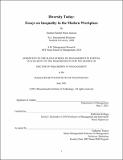Diversity Today: Essays on Inequality in the Modern Workplace
Author(s)
Jackson, Summer Rachel Maria
DownloadThesis PDF (1.544Mb)
Advisor
Kellogg, Katherine
Terms of use
Metadata
Show full item recordAbstract
My dissertation seeks to contribute to our understanding of how and when organizations can achieve diverse, equitable, and inclusive organizations using empirical and theoretical perspectives.
In Chapter 1, I explore the question of how organizations can hire individuals from underrepresented backgrounds. Past studies highlight a combination of demand- and supply-side constraints that create a ‘thin labor market’ for candidates from underrepresented backgrounds. Drawing on data from a 20-month ethnographic study of a fast-growth technology firm (“ShopCo,” a pseudonym), I examined ShopCo’s efforts to increase representation of racial minorities in technical positions and reveal a previously unrecognized barrier to hiring racial minorities into organizations: repugnant market concerns. In Chapter 2, Basima Tewfik (coauthor) and I theorize on the relationship between microaggressions and systemic prejudice. We offer a precise definition of microaggressions at work and propose how multi-level responses (i.e., target, workgroup, and organization) to microaggressions can intensify and amplify to either inhibit or facilitate organizational progress on addressing systemic prejudice. In Chapter 3, I use data from an 18-month ethnography of a public defender agency to develop grounded theory on the role of racial and economic disenfranchisement on an advocate’s ability to successfully influence a higher-power target. I found that public defenders needed to first manage the impressions of their clients – using triadic advocacy tactics designed to address the racial and economic barriers – before attempting to influence the more powerful district attorneys.
Date issued
2021-06Department
Sloan School of ManagementPublisher
Massachusetts Institute of Technology